Wanda Treumann (1883–1963) belonged to the most popular stars of the German cinema before the First World War. She played the lead in nearly 90 films, but many of them were shorts. Together with Viggo Larsen she also produced more than 80 films in the 1910s.
Image may be NSFW.
Clik here to view.
German postcard by Photochemie, Berlin, no. K. 2339. Photo: Traumann-Larsen-Film.
Image may be NSFW.
Clik here to view.
German postcard by NPG, no. 544. Photo A. Binder, Berlin.
Image may be NSFW.
Clik here to view.
German postcard by Verlag Hermann Wolff, Berlin, no. F 7. Photo: Alex Binder.
Image may be NSFW.
Clik here to view.
German postcard by NPG, no. 259. Photo: Alex Binder, Berlin.
Image may be NSFW.
Clik here to view.
German postcard by Photochemie, Berlin, no. K. 210. Photo: A. Binder, Berlin.
Wanda Treumann was born Wanda Reich in Koclo (Koclin), Oberschlesien (Upper Silesia), Germany (now Koclin, Slaskie, Poland) in 1883 (some sources say 1888 or 1889). Wanda married Karl Treumann in 1903 in her native town. She came with him first to Leipzig and then to Berlin.
In Berlin, she took acting lessons from Emanuel Reicher. She debuted on stage at the Trianon Theater in 1910 and performed as a stage actress on various Berlin stages, such as das Neue Theater and the Königgrätzer Theater.
When performing at the Berliner Lustspielhaus, Wanda Treumann was discovered by the Danish actor and film pioneer Viggo Larsen. He introduced her to the cinema, where she would be his partner for years.
From 1910 on, Treumann and Larsen performed together in films by the Vitascope-Gesellschaft such as the successful Sensation film Der Eid des Stephan Huller/The oath of Stephan Huller (Viggo Larsen, 1912). Many of these films were produced by Jules Greenbaum, scripted by Max Mack, and directed by either Walter Schmidthassler or Larsen himself.
In 1912, together with Larsen and her husband, she founded her own production company Treumann-Larsen Film GmbH in Berlin. Officially, Wanda Treumann’s husband was indicated as the owner of the firm. As she said herself in Lichtbild-Theater, no. 41, 1912: "Then we – my master and partner in the film, Mr. Oberregisseur Viggo Larsen and me – became fully independent. And so we are now: for the production of our new 'Treumann-Larsen-series', we develop the negatives ourselves which we shoot in our own film studio with our own cast and crew."
Image may be NSFW.
Clik here to view.
German postcard in the Film-Sterne series by Rotophot, no. 85/2. Photo: Karl Schenker, Berlin / Messter Film, Berlin.
Image may be NSFW.
Clik here to view.
German postcard in the Film Sterne series by Rotophot, no. 85/3. Photo: Karl Schenker, Berlin / Messter Film, Berlin.
Image may be NSFW.
Clik here to view.
German postcard in the Film Sterne series by Rotophot, no. 86/1. Photo: Karl Schenker, Berlin / Messter Film, Berlin.
Image may be NSFW.
Clik here to view.
German postcard in the Film Sterne series by Rotophot, no. 86/2. Photo: Karl Schenker, Berlin / Messter Film, Berlin.
Image may be NSFW.
Clik here to view.
German postcard in the Film Sterne series by Rotophot, no. 87/1. Photo: Karl Schenker, Berlin / Messter Film, Berlin.
Image may be NSFW.
Clik here to view.
German postcard in the Film Sterne series by Rotophot, no. 87/2. Photo: Karl Schenker / Messter Film, Berlin.
Image may be NSFW.
Clik here to view.
German postcard in the Film Sterne series by Rotophot, no. 87/3. Photo: Karl Schenker, Berlin / Messter Film.
Image may be NSFW.
Clik here to view.![Wanda Treumann]()
German postcard in the Film Sterne series by Rotophot, no. 87/4. Photo: Karl Schenker, Berlin / Messter Film.
From 1912 on, Wanda Treumann produced more than 80 films. Directors at Treumann-Larsen Film were a.o. Rosa Porten and Franz Eckstein. Distribution was taken care of by the Deutsche Kinematographen-Gesellschaft in Cologne.
Examples of their films are Die Sumpfblume/The marsh flower (Viggo Larsen, 1913), Der Zirkusteufel/The Circus Devil (Viggo Larsen, 1913), and Die Ahnfrau/The ancestress (Viggo Larsen, 1914).
After the outbreak of the First World War, production at Treumann-Larsen seems to have stopped. Larsen and Treumann performed in some films by the Messter Film company. From 1917 on, production at Treumann-Larsen was reactivated, with productions such as Wanda’s Trick (1918) and the four-part series film Die Frau mit den 10 Masken/The woman with 10 masks (Siegfried Dessauer, 1921) with Johannes Riemann.
From the late 1910s on, Larsen solely focused on producing, leaving the male leads to such actors as Eugen Burg and Oscar Marion. When he left the company around 1921, Wanda Treumann continued on her own as producer and actress, keeping the name of the company.
In 1921 she gave a guest performance as a witch in the Circus Busch in Hamburg. According to our sources, Die tugendhafte Tänzerin/The virtuous dancer (Robert Misch, 1922) was the last film in which Treumann performed and which was produced by the Treumann-Larsen Film GmbH. All in all, Wanda Treumann acted in over 80 films and (co-)produced some 24 films.
Little was known about her death till recently. An editor of German Wikipedia recently added new information. After she retired from the film business in 1922, Wanda Treumann still appeared in plays for a while, for example in 1929 she played in 'Ein Geschlecht', but without achieving the broad impact of earlier years.
After Karl Treumann's death in 1927, she married the publisher Hans Brenner in 1932, from whom she divorced again in 1937. In early 1938, Wanda Treumann, a Jew, emigrated with her son Herbert Treumann aboard the SS Esquilino via Port Said and Fremantle to Melbourne. She died in Melbourne in 1963 at the age of 79 and was buried in the Jewish sector of the Fawkner Memorial Park there.
Image may be NSFW.
Clik here to view.![Wanda Treumann in Das Teufelchen (1917)]()
German postcard by Verlag Herm. Leiser, Berlin-Wilm., no. 3237. Wanda Treumann in Das Teufelchen/The little devil (Rosa Porten, 1917).
Image may be NSFW.
Clik here to view.![Wanda Treumann in Im Schloss am See]()
German postcard by Verlag Hermann Leiser, Berlin, no. 5444. Photo: Treumann-Larsen Film. Wanda Treumann in Schloss am See (Eugen Burg, 1918). Treumann's co-actors in this film were a.o. Eugen Burg, Karl Beckersachs and Reinhold Schünzel. It was approved by the German censor in May 1918.
Image may be NSFW.
Clik here to view.![Wanda Treumann in Das Opfer der Yella Rogesius]()
German postcard by Verlag Hermann Leiser, Berlin, no. 9228. Photo: Treumann-Larsen Film. Wanda Treumann in Das Opfer der Yella Rogesius (Dr. R. Portegg = Franz Eckstein, Rosa Porten, 1917).
Image may be NSFW.
Clik here to view.![Wanda Treumann]()
German postcard by Photochemie, no. K. 2141. Photo: Mac Walten, Berlin.
Image may be NSFW.
Clik here to view.![Wanda Treumann in Elly und Nelly]()
German postcard by Photochemie, no. K. 2678. Photo: Treumann-Larsen Film. Wanda Treumann in the German silent comedy Elly und Nelly (Eugen Burg, 1918). The film passed German censorship in August 1918.
Image may be NSFW.
Clik here to view.![Wanda Treumann in Das Hexenlied (1917)]()
German postcard by Photochemie, no. K. 2900. Photo: Treumann-Larsen Film. Wanda Treumann in Das Hexenlied (Eugen Burg, 1919).
Image may be NSFW.
Clik here to view.![Wanda Treumann in Das Hexenlied]()
German postcard by Photochemie, no. K. 2901. Photo: Treumann-Larsen Film. Wanda Treumann in Das Hexenlied (Eugen Burg, 1919).
Image may be NSFW.
Clik here to view.![Wanda Treumann]()
German postcard by Photochemie, Berlin, no. K. 208. Photo: Alex Binder, Berlin.
Image may be NSFW.
Clik here to view.![Wanda Treumann]()
German postcard by Photochemie, Berlin, no. K. 209. Photo: Alex Binder, Berlin.
Image may be NSFW.
Clik here to view.![Wanda Treumann]()
German postcard by Verlag Hermann Leiser, Berlin, no. 1523. Photo: Gerlach & Co., Berlin.
Image may be NSFW.
Clik here to view.![Wanda Treumann]()
German postcard in the Film-Sterne series by Rotophot, no. 153/4. Photo: Becker & Maass, Berlin.
Image may be NSFW.
Clik here to view.![Wanda Treumann]()
German postcard in the Film Sterne series by Rotophot, no. 153/5. Photo: Becker & Maass, Berlin.
Image may be NSFW.
Clik here to view.![Wanda Treumann]()
German collectors card by Ross Verlag in the series Vom Werden Deutscher Filmkunst - Der Stumme Film, picture no. 20, Group 43. Photo: Karl Schenker. Caption: "Wanda Treumann, jahrelang die Partnerin von Viggo Larsen".
Image may be NSFW.
Clik here to view.![Wanda Treumann]()
German postcard in the Moderne Künstler serie by MMB, no. 461. Picture: F.J. Wesselsky.
Sources: Thomas Staedeli (Cyranos), Elfgiva@web.de (IMDb), Filmportal.de (German), Wikipedia (German), and IMDb.
Thank you, Elif Kaynakci, for attending us at the new info!
Image may be NSFW.
Clik here to view.

German postcard by Photochemie, Berlin, no. K. 2339. Photo: Traumann-Larsen-Film.
Image may be NSFW.
Clik here to view.
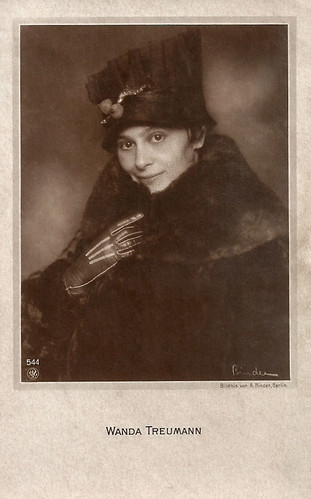
German postcard by NPG, no. 544. Photo A. Binder, Berlin.
Image may be NSFW.
Clik here to view.
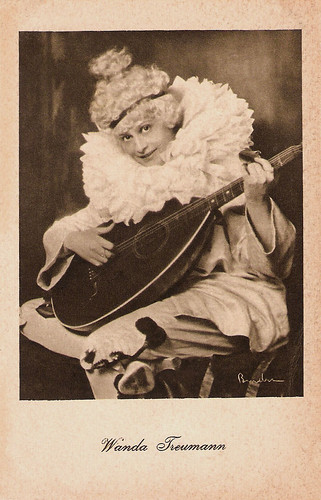
German postcard by Verlag Hermann Wolff, Berlin, no. F 7. Photo: Alex Binder.
Image may be NSFW.
Clik here to view.
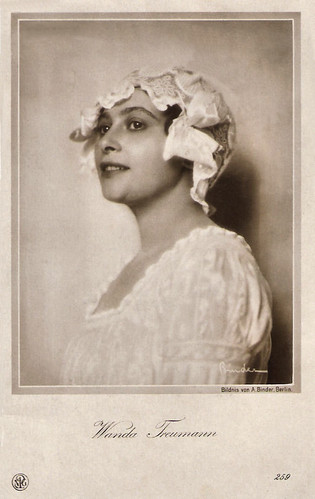
German postcard by NPG, no. 259. Photo: Alex Binder, Berlin.
Image may be NSFW.
Clik here to view.

German postcard by Photochemie, Berlin, no. K. 210. Photo: A. Binder, Berlin.
Fully independent
Wanda Treumann was born Wanda Reich in Koclo (Koclin), Oberschlesien (Upper Silesia), Germany (now Koclin, Slaskie, Poland) in 1883 (some sources say 1888 or 1889). Wanda married Karl Treumann in 1903 in her native town. She came with him first to Leipzig and then to Berlin.
In Berlin, she took acting lessons from Emanuel Reicher. She debuted on stage at the Trianon Theater in 1910 and performed as a stage actress on various Berlin stages, such as das Neue Theater and the Königgrätzer Theater.
When performing at the Berliner Lustspielhaus, Wanda Treumann was discovered by the Danish actor and film pioneer Viggo Larsen. He introduced her to the cinema, where she would be his partner for years.
From 1910 on, Treumann and Larsen performed together in films by the Vitascope-Gesellschaft such as the successful Sensation film Der Eid des Stephan Huller/The oath of Stephan Huller (Viggo Larsen, 1912). Many of these films were produced by Jules Greenbaum, scripted by Max Mack, and directed by either Walter Schmidthassler or Larsen himself.
In 1912, together with Larsen and her husband, she founded her own production company Treumann-Larsen Film GmbH in Berlin. Officially, Wanda Treumann’s husband was indicated as the owner of the firm. As she said herself in Lichtbild-Theater, no. 41, 1912: "Then we – my master and partner in the film, Mr. Oberregisseur Viggo Larsen and me – became fully independent. And so we are now: for the production of our new 'Treumann-Larsen-series', we develop the negatives ourselves which we shoot in our own film studio with our own cast and crew."
Image may be NSFW.
Clik here to view.

German postcard in the Film-Sterne series by Rotophot, no. 85/2. Photo: Karl Schenker, Berlin / Messter Film, Berlin.
Image may be NSFW.
Clik here to view.

German postcard in the Film Sterne series by Rotophot, no. 85/3. Photo: Karl Schenker, Berlin / Messter Film, Berlin.
Image may be NSFW.
Clik here to view.

German postcard in the Film Sterne series by Rotophot, no. 86/1. Photo: Karl Schenker, Berlin / Messter Film, Berlin.
Image may be NSFW.
Clik here to view.

German postcard in the Film Sterne series by Rotophot, no. 86/2. Photo: Karl Schenker, Berlin / Messter Film, Berlin.
Image may be NSFW.
Clik here to view.

German postcard in the Film Sterne series by Rotophot, no. 87/1. Photo: Karl Schenker, Berlin / Messter Film, Berlin.
Image may be NSFW.
Clik here to view.

German postcard in the Film Sterne series by Rotophot, no. 87/2. Photo: Karl Schenker / Messter Film, Berlin.
Image may be NSFW.
Clik here to view.

German postcard in the Film Sterne series by Rotophot, no. 87/3. Photo: Karl Schenker, Berlin / Messter Film.
Image may be NSFW.
Clik here to view.

German postcard in the Film Sterne series by Rotophot, no. 87/4. Photo: Karl Schenker, Berlin / Messter Film.
Treumann-Larsen Film GmbH
From 1912 on, Wanda Treumann produced more than 80 films. Directors at Treumann-Larsen Film were a.o. Rosa Porten and Franz Eckstein. Distribution was taken care of by the Deutsche Kinematographen-Gesellschaft in Cologne.
Examples of their films are Die Sumpfblume/The marsh flower (Viggo Larsen, 1913), Der Zirkusteufel/The Circus Devil (Viggo Larsen, 1913), and Die Ahnfrau/The ancestress (Viggo Larsen, 1914).
After the outbreak of the First World War, production at Treumann-Larsen seems to have stopped. Larsen and Treumann performed in some films by the Messter Film company. From 1917 on, production at Treumann-Larsen was reactivated, with productions such as Wanda’s Trick (1918) and the four-part series film Die Frau mit den 10 Masken/The woman with 10 masks (Siegfried Dessauer, 1921) with Johannes Riemann.
From the late 1910s on, Larsen solely focused on producing, leaving the male leads to such actors as Eugen Burg and Oscar Marion. When he left the company around 1921, Wanda Treumann continued on her own as producer and actress, keeping the name of the company.
In 1921 she gave a guest performance as a witch in the Circus Busch in Hamburg. According to our sources, Die tugendhafte Tänzerin/The virtuous dancer (Robert Misch, 1922) was the last film in which Treumann performed and which was produced by the Treumann-Larsen Film GmbH. All in all, Wanda Treumann acted in over 80 films and (co-)produced some 24 films.
Little was known about her death till recently. An editor of German Wikipedia recently added new information. After she retired from the film business in 1922, Wanda Treumann still appeared in plays for a while, for example in 1929 she played in 'Ein Geschlecht', but without achieving the broad impact of earlier years.
After Karl Treumann's death in 1927, she married the publisher Hans Brenner in 1932, from whom she divorced again in 1937. In early 1938, Wanda Treumann, a Jew, emigrated with her son Herbert Treumann aboard the SS Esquilino via Port Said and Fremantle to Melbourne. She died in Melbourne in 1963 at the age of 79 and was buried in the Jewish sector of the Fawkner Memorial Park there.
Image may be NSFW.
Clik here to view.

German postcard by Verlag Herm. Leiser, Berlin-Wilm., no. 3237. Wanda Treumann in Das Teufelchen/The little devil (Rosa Porten, 1917).
Image may be NSFW.
Clik here to view.

German postcard by Verlag Hermann Leiser, Berlin, no. 5444. Photo: Treumann-Larsen Film. Wanda Treumann in Schloss am See (Eugen Burg, 1918). Treumann's co-actors in this film were a.o. Eugen Burg, Karl Beckersachs and Reinhold Schünzel. It was approved by the German censor in May 1918.
Image may be NSFW.
Clik here to view.

German postcard by Verlag Hermann Leiser, Berlin, no. 9228. Photo: Treumann-Larsen Film. Wanda Treumann in Das Opfer der Yella Rogesius (Dr. R. Portegg = Franz Eckstein, Rosa Porten, 1917).
Image may be NSFW.
Clik here to view.
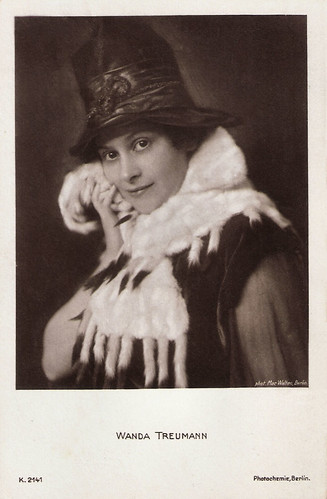
German postcard by Photochemie, no. K. 2141. Photo: Mac Walten, Berlin.
Image may be NSFW.
Clik here to view.

German postcard by Photochemie, no. K. 2678. Photo: Treumann-Larsen Film. Wanda Treumann in the German silent comedy Elly und Nelly (Eugen Burg, 1918). The film passed German censorship in August 1918.
Image may be NSFW.
Clik here to view.

German postcard by Photochemie, no. K. 2900. Photo: Treumann-Larsen Film. Wanda Treumann in Das Hexenlied (Eugen Burg, 1919).
Image may be NSFW.
Clik here to view.

German postcard by Photochemie, no. K. 2901. Photo: Treumann-Larsen Film. Wanda Treumann in Das Hexenlied (Eugen Burg, 1919).
Image may be NSFW.
Clik here to view.

German postcard by Photochemie, Berlin, no. K. 208. Photo: Alex Binder, Berlin.
Image may be NSFW.
Clik here to view.

German postcard by Photochemie, Berlin, no. K. 209. Photo: Alex Binder, Berlin.
Image may be NSFW.
Clik here to view.
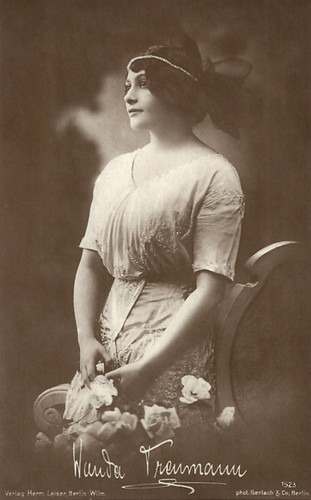
German postcard by Verlag Hermann Leiser, Berlin, no. 1523. Photo: Gerlach & Co., Berlin.
Image may be NSFW.
Clik here to view.

German postcard in the Film-Sterne series by Rotophot, no. 153/4. Photo: Becker & Maass, Berlin.
Image may be NSFW.
Clik here to view.

German postcard in the Film Sterne series by Rotophot, no. 153/5. Photo: Becker & Maass, Berlin.
Image may be NSFW.
Clik here to view.

German collectors card by Ross Verlag in the series Vom Werden Deutscher Filmkunst - Der Stumme Film, picture no. 20, Group 43. Photo: Karl Schenker. Caption: "Wanda Treumann, jahrelang die Partnerin von Viggo Larsen".
Image may be NSFW.
Clik here to view.

German postcard in the Moderne Künstler serie by MMB, no. 461. Picture: F.J. Wesselsky.
Sources: Thomas Staedeli (Cyranos), Elfgiva@web.de (IMDb), Filmportal.de (German), Wikipedia (German), and IMDb.
Thank you, Elif Kaynakci, for attending us at the new info!